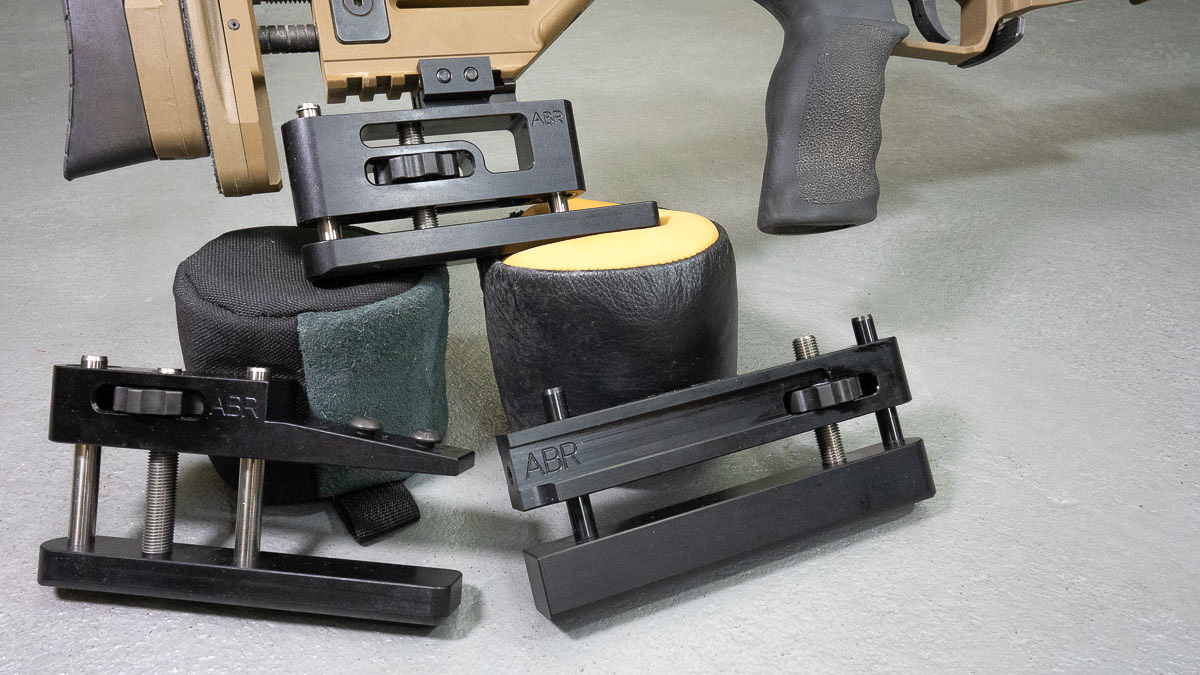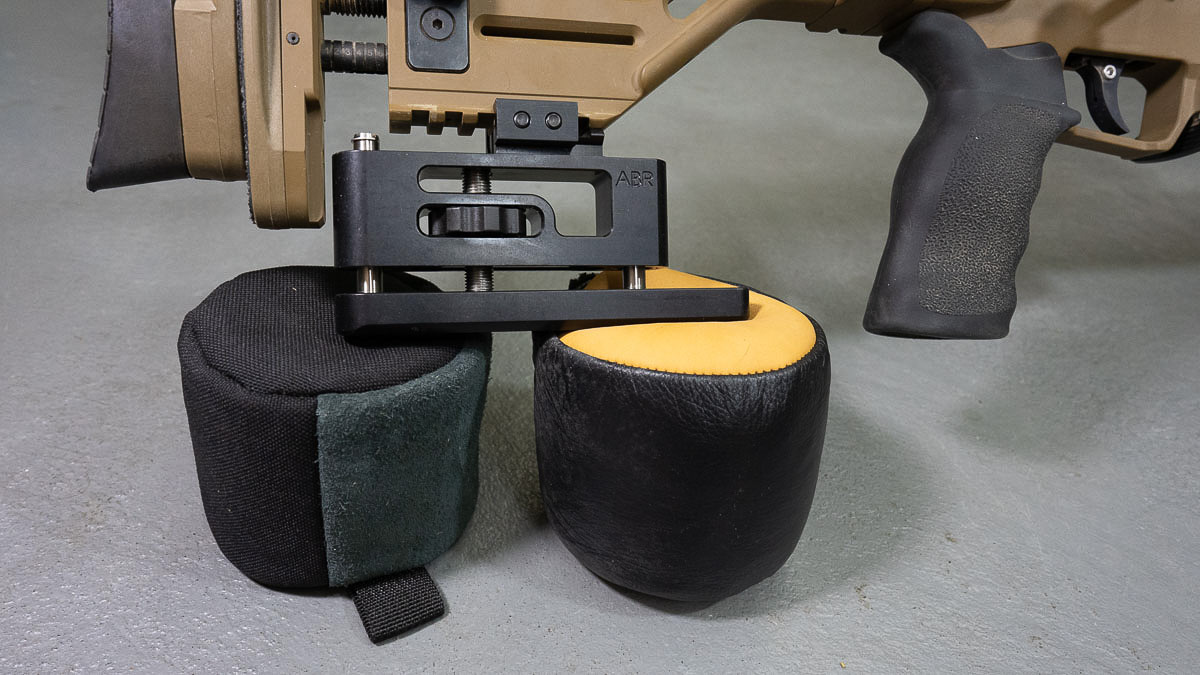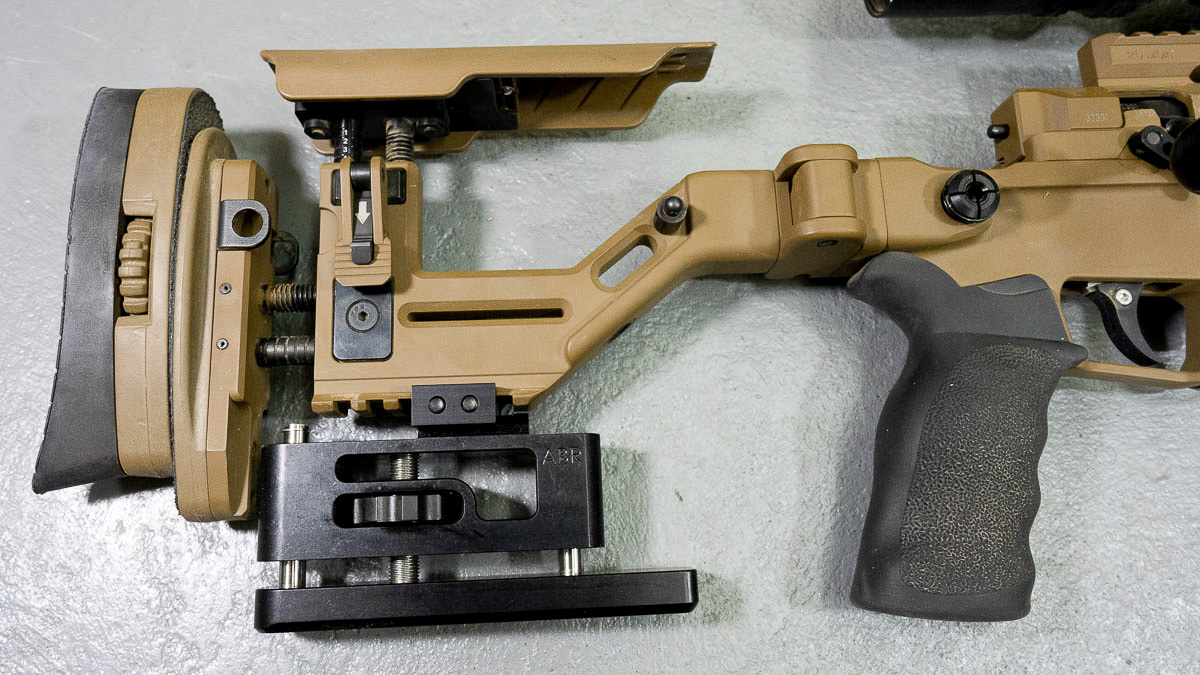We may earn revenue from the products available on this page and participate in affiliate programs. Learn More ›
The Adjustable Bag Rider tackles two issues at once, both of which are of paramount concern to long-range shooters. First, it creates an ample area of support on the underside of the buttstock so shooters can build a secure rest for their rifle. Second, it lets the shooter make precise adjustments to the elevation of their crosshairs by virtue of a threaded wheel that raises or lowers the base of the bag rider.
The ABR was designed by Dave Pobutkiewicz who has more than 20 years of experience fabricating precision tool and die items. An avid long-range shooter, Pobutkiewicz saw the need for a better way to make vertical adjustments to a rifle’s position. Prior to this, shooters would fall into the categories of “bag squeezer” or machine rest users—sometimes both.
Squeezing a rear bag works, but it can be difficult to hold a correct position for longer periods of time and is inherently less consistent. High tech bench rests, the majority of which support the fore-end of the rifle, can make precise, minute adjustments to point of aim, but they are heavy, expensive, and cumbersome to transport. I don’t know if Pobutkiewicz looked at it this way, exactly, but what the ABR does is take a portion of the machine rest and let the shooter attach it to the rear of the rifle.
ABRs for Various Chassis Systems
ABRs are available for a wide variety of rifles, though Pobutkiewicz got his start by making one for the Ruger Precision Rifle. His goal was to create a unit that would clamp on to the rifle easily with basic tools. The one on my Accuracy International, pictured here, uses two Allen key fasteners that took only a couple minutes to install.
ABRs are available for numerous different rifles/chassis systems. These include MDT, MPA, XLR, Ruger RPR, Accuracy International, Barrett, Tikka T3X and Tac A1, GRS, Christensen MPR, Desert Tech, Magpul PRS3, Cadex, SCAR, Victrix, Oryx, Target Tool and Daystate. There are also other rifles that can use ABRs provided the underside of a stock can accommodate a length of Picatinny rail. With minor modifications to the stock, the ABR can be mounted on Ruger Precision Rimfire Rifles, Luth-AR stocks, Savage Axis II, and the Daniel Defense Delta 5.
When selecting an ABR, you not only need to know the model of your rifle—all the attachments systems are unique to specific brands—but with some guns you need to take into consideration how the length of pull is set up on your gun. If the LOP is short, it might require one type of clamping interface, and if it is longer, another. Though that might sound daunting, Pobutkiewicz is easy to work with. He provides one-on-one feedback to make sure you get the right version.
One final consideration is the shape of the base of the bag rider. The adjustable bag riders can be had with a flat square bottom—which is what I chose—or with a V-shaped profile that is designed to ride in the notch between some bunny-ear style bags. The flat square bottom, which is .85 inches wide, is the more versatile of the two. But if you shoot consistently with a quality rear bag, like those made by Protektor Model, the V-shaped profile is a great option.

Adjustable Bag Rider in The Field
With an ABR attached, the butt of a rifle will ride higher above the ground than before—count on two or three inches. So, you have to make sure your bipod extends far enough to elevate the muzzle adequately for shots on flat terrain and uphill. The Elite Iron Revolution bipod on my ASXR has long legs to begin with (9 inches from where it pivots on the housing to the base of the feet) with an additional 6 inches of length when fully extended. That’s more than enough to compensate for the extra height of the ABR.
I did my shooting with two different rear bags. One is the waxed canvas Armageddon Gear Gamechanger with Git-Lit fill that goes with me everywhere I hunt or shoot. I’m more attached to that bag than Linus is to his blanket. I also used a bag of Pobutkiewicz’s design, a small and sturdy cylinder made of Cordura and felt that is about the size of two cans of tuna fish stacked on each other.
It’s called the LSP Small Bag (the letters stand for Long Shot Precision) and is a handy and portable bag. Though it has a small footprint it still provides a great deal of stability. The bag has two panels of felt, one on one end of the cylinder and the other covering about a third of the circumference of the bag. The bag is designed to be used with the felt in contact with the surface being shot off. The felt will grip the ground, wood, or concrete and stay put while the rail on the ABR glides smoothly over the Cordura allowing the rifle to track cleanly in and out of recoil.
Superior Recoil Management with the ABR
The ABR worked well with both rear supports. The AI ASXR handles recoils like a champ, even when chambered in the stout .300 Norma Magnum, as mine is. With the ABR on the stock I found the rifle’s already excellent ergonomics noticeably improved. The odd-shaped piece of nylon that comes stock on the ASXR doesn’t have much surface engagement, so swapping to the larger bottom piece on the ABR was a big step up. The rifle tracked great on both bags, and I experienced less reticle jump than before.
The real magic of the ABR is the wheel that raises and lowers the base to fine tune the vertical position of the crosshairs. With the ABR pressed firmly into either bag so that they take a set—that’s the beauty of the lightweight Git-Lite fill, which provides sand-like stability at a fraction of the weight—the crosshairs don’t budge until you manipulate the wheel.

Silky Elevation Adjustments
One concern I had about the ABR was the ergonomics of the wheel position and whether it would function well under real-world conditions. Turns out I need not have worried. With my support (non-shooting) hand resting on the rear bag I was able to access and turn the wheel easily without needing to contort my wrist or otherwise compromise the shooting position.
The wheel itself turns and glides smoothly and precisely adjusts the elevation of the crosshairs. The scope on my rifle, a Nightforce ATACR 7-35×56, has the Mil-C reticle, which is one of the best out there for ELR shooting. The floating center dot allows for pin-point placement on the target and delivers a clean sight picture no matter the distance. The reticle and Adjustable Bag Rider paired together like a fine vintage port and Stilton cheese.
Improved Rifle Balance
Another benefit of the Adjustable Bag Rider is that it puts some extra weight into the rifle in a useful spot—the butt stock. For guns that are only shot prone—belly guns—rifle balance isn’t a concern. But for competitions and shooting scenarios where the rifle might be shot off barricades, vehicles, rocks, downed trees, and other non-prone positions it’s important to have a rifle that balances reasonably well. In general, precision rifles with their thick steel barrels, large bipods, and big suppressors tend to be muzzle heavy. So, getting a few extra ounces at the rear of the rifle is a boon for those who care about such things.
Read Next: How To Get The Most Out Of Your Precision Riflescope
Final Thoughts on the ABR
For shooters looking to squeeze extra accuracy out of their precision rifles, the ABR is a smart option. In terms of cost, they run about $235, so while not cheap they aren’t outrageously priced either. Especially when you consider that a weekend of intense precision rifle shooting will set you back that much in reloading components alone. And given the quality of their construction, the price isn’t out of line. They do add some bulk to the rifle and raise the height of the butt, so that needs to be factored in. But as a marksmanship aid that will benefit a shooter in practical, real-world situations, it is one of the better accessories to hit the scene in recent years.
